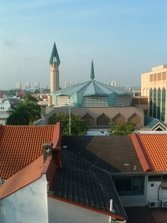By Jovanda Biston
Article taken from: A Singapore Trishaw Driver
SINGAPORE (Reuters Life!) - Five years ago, Soong Chwee Boo hung up his butcher's knife for the last time and turned to peddling to make a living.
Boo is a trishaw driver, one of a few who still provide a form of once popular form of transport that is now part of Singapore's history.
A Chinese couple pose on a trishaw on Singapore's tourist resort island of Sentosa Island in this file photo. Gone are the days when trishaws plied the roads of Singapore, ferrying residents -- now most customers are tourists keen to see the sights. (REUTERS/Stringer/Files)
"You might think being a butcher is easier but it is hard work. Peddling a trishaw is a lot easier now that I am old," the 61-year-old said of his new job.
Trishaws evolved from the manually pulled Japanese "jinrikisha" and these three-wheeled vehicles with the passenger seat mounted beside the driver became a popular mode of transport in Singapore in the early 20th century.
But gone are the days when trishaws plied the roads of Singapore, ferrying residents -- now most of Boo's customers are tourists keen to see the sights.
"Sometimes, old local residents ask to take my trishaw but I'll tell them nicely to take the bus or taxi. Trishaw rides are too expensive for Singaporeans," said Boo, who is licensed by the Singapore Tourism Board.
"It's all for tourists now. The tour guides book with my boss in advance for trishaw tours for their clients. I come at around 1 p.m. every day so I can be one of the first few in line."
Boo's home is a small government-subsidised flat 20-minute walk away from his manager's trishaw garage in Bugis. He wakes up before 10 a.m. each day, but only starts work after lunch.
His uniform is a bright lime green polo T-shirt and sports shoes his son bought him a few months ago. "We trishaw drivers have to look neat for the tourists," he said.
In the early afternoons, Boo's passengers are usually Japanese tourists who like to tour the historic Raffles Hotel area, while in the evenings, he gets more Korean tourists.
When it is sunny, he can take home about 60 Singapore dollars ($40), but he often contends with half that amount on rainy days.
Boo proudly says that he has learnt to speak a little Japanese and Korean, which pleases his clients.
"When they are in my trishaw, I am their guide so I have to tell them about the sights. They are always happy when I can describe places in their native language," he added.
In the evenings, trishaw tours to the lively Clarke Quay area are very popular with tourists about to start their evening of dining and entertainment.
His last passengers usually stop there and Boo rides back to Bugis to park his trishaw in the garage and have a dinner of roast pork and rice. "I drink a lot of sugarcane juice too. I get very thirsty and sugarcane juice is most refreshing," he added.
Boo says he has yet to have any accidents, mainly because he is a careful driver, but he still seeks divine protection against traffic mishaps: a Buddhist charm, "Namo Amida Buddha", is emblazoned in bright yellow against the scarlet back cushion of the passenger seat.
"I have not thought about retiring yet. There are many older trishaw drivers than me who are still going strong," he added.
*** For Singapore pictures and itineraries, visit www.traveljournal.com.ph.
Subscribe to:
Post Comments (Atom)

No comments:
Post a Comment